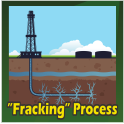Let's TALK Natural Gas History
Did you know, the Chinese used gas from shallow wells to burn it under large pans and evaporate seawater for salt? In fact, ancient cultures (pre-1800's) discovered natural gas and were mystified by it's presence.
(Fun Fact: Raw natural gas is odorless, colorless and tasteless so it wasn't until modern time that natural gas companies addded a chemical to natural gas to give it the smell of "rotten eggs" so it could be detected).
Fastforward to 1821...
Fredonia, NY - The first successful natural gas well was dug.
Fastforward to 1958 - same town... Fredonia Gas Light Company began America's first natural gas company.
Hard to believe that in 2012... Natural gas accounts for 24% of the energy we use in the United States. Coal accounts for 23%.
How does Natural Gas Form? Scientists believe that natural gas was formed from the remains of tiny sea animals and plants that died nearly 400 million years old... this is why natural gas is generally considered a non-renewable resource. The sea animals and plants would sink to the bottom of the oceans and buried under layers of sediment, that eventually turned into rock. Over millions of years, scientists believe that the rock which was thousands of layers thick subjected the remains to enormous pressure. It is predicted that the pressure and heat combined changed the remains into pertroleum and natural gas.








